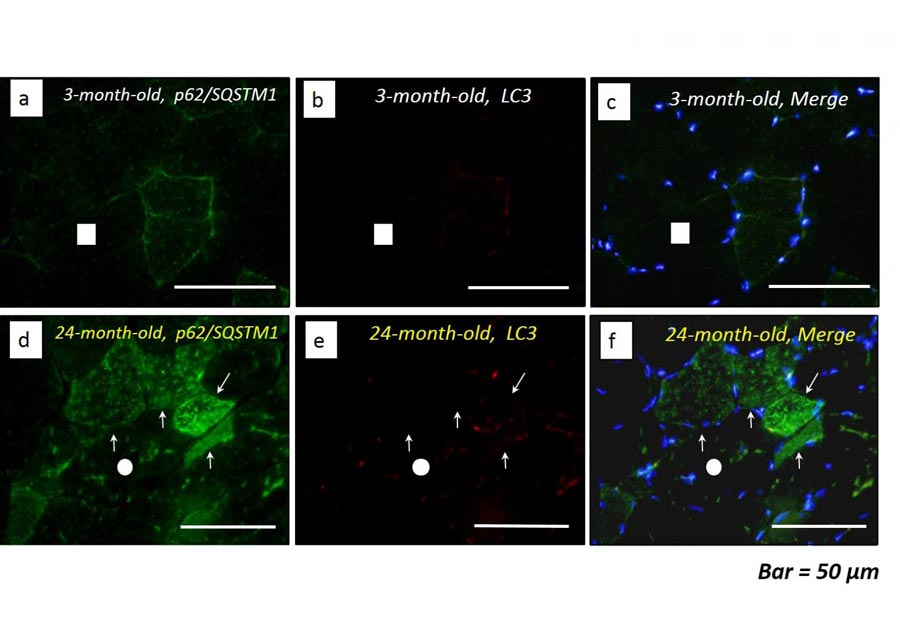

P62/SQSTM1, but not LC3, is markedly expressed in the cytosol of muscle fibers of sarcopenic mice.
COPYRIGHT (C) 2015 TOYOHASHI UNIVERSITY OF TECHNOLOGY. ALL RIGHTS RESERVED
Sarcopenia is the aging-related loss of skeletal muscle mass and strength. Preventing sarcopenia is important for maintaining a high quality of life (QOL) in the aged population. However, the molecular mechanism of sarcopenia has not yet been unraveled and is still a matter of debate.
Determining whether the levels of autophagy-related mediators (e.g., p62/SQSTM1, LC3, etc.) in muscle change with ageing is important to understanding sarcopenia. Such information could enhance the therapeutic strategies for attenuating mammalian sarcopenia.
In previous studies, autophagic defects were detected in the sarcopenic muscle of mice, rats, and humans. However, all these studies involved only western blotting analyses of crude not cell-fractionated muscle homogenates. Thus, these data were insufficient to describe the adaptive changes in autophagy-linked molecules within sarcopenic muscle.
Associate Professor Kunihiro Sakuma and his colleagues at Toyohashi Tech found a marked accumulation of p62/SQSTM1 in the sarcopenic quadriceps muscle of mice using two different methods (western blotting of cell-fractionated homogenates and immunofluorescence). In contrast, the expression level of LC3, a partner of p62/SQSTM1 in autophagy progression, was not modulated.
The found autophagic defect improves our understanding of the mechanism underlying sarcopenia. The researchers would like to further study this mechanism with an aim to attenuate sarcopenia by improving this autophagic defect using nutrient- and pharmaceutical-based treatments.
###
Reference:
Authors: Kunihiro Sakuma1, Masakazu Kinoshita1, Yoshinori Ito1, Miki Aizawa1, Wataru Aoi2, and Akihiko Yamaguchi3
Title of original paper: p62/SQSTM1 but not LC3 is accumulated in sarcopenic muscle of mice Journal of Cachexia, Sarcopenia, and Muscle, vol. 6, 2015 (in press)
Affiliation(s): 1Research Center for Physical Fitness, Sports and Health, Toyohashi University of Technology, Toyohashi, Aichi, Japan, 2Laboratory of Health Science, Graduate School of Life and Environmental Sciences, Kyoto Prefectural University, Kyoto, Japan, 3Department of Physical Therapy, Heath Science University of Hokkaido, Kanazawa, Ishikari-Tobetsu, Hokkaido, Japan
Further information:
Toyohashi University of Technology
1-1 Hibarigaoka, Tempaku
Toyohashi, Aichi Prefecture 441-8580, JAPAN
Inquiries: Committee for Public Relations
E-mail: press@office.tut.ac.jp
Toyohashi University of Technology, which was founded in 1976 as a National University of Japan, is a leading research institute in the fields of mechanical engineering, advanced electronics, information sciences, life sciences, and architecture.
Website: http://www.












